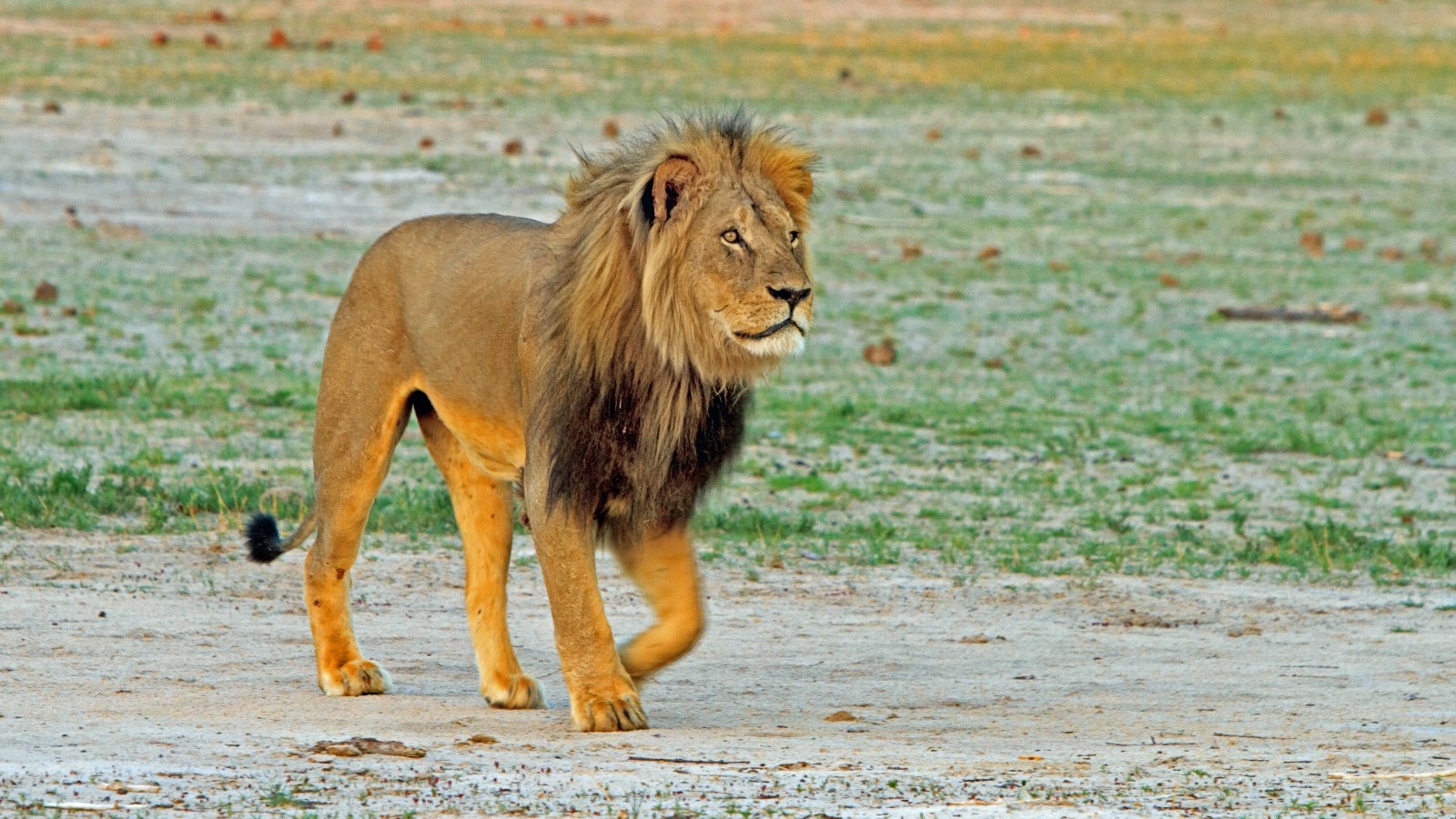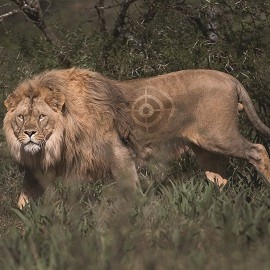Hunting trophies – get the ban done
19 July 2023
HUNTING TROPHIES – GET THE BAN DONE
Eight years ago, the shocking death of Cecil the lion alerted the world to the cruel and damaging practice of trophy hunting. Head of Policy, veterinarian Mark Jones, explains why the UK’s Hunting Trophies (Import Prohibition) Bill represents an important opportunity for the UK to play its part in bringing trophy hunting to an end.

The beginning of July marked the 8th anniversary of the death of Cecil the lion in Zimbabwe at the hands of an American trophy hunter.

Head of Policy, Dr Mark Jones
Since that tragic event in 2015, exports of some 205,000 wildlife trophy items derived from internationally protected species have been declared by almost 100 countries, more than 1,000 of which were reported to have been exported to the UK. Among these, around 5,700 were from lions with the UK being the destination for around 70 lion trophies.
The killing of Cecil sparked international outrage. While the killing of a lion in southern Africa by a foreign trophy hunter was by no means a unique event, there were several factors that made his case so poignant.
Cecil was a magnificent, dark-maned lion, the leader of two prides. He was collared as part of an ongoing international conservation research project. He was reportedly lured out of the safety of the national park in which he lived by the hunting guide so the wealthy American hunter could shoot him. He was targeted with a bow, was injured with the first shot and reportedly only killed several hours later after a long and no doubt extremely painful and stressful pursuit.
The killing of Cecil embodies many of the reasons why I find trophy hunting so abhorrent.
First, trophy hunting damages efforts to conserve threatened populations of wild animals.
 Contrary to some of the claims made by hunting apologists, hunters typically don’t target ‘redundant’, ‘surplus’ or ‘nuisance animals – they target the animals that make the best trophies because they have the largest tusks, the biggest horns, or the darkest manes. These are typically key individuals within their family groups and wider populations, and their removal has profound implications for the genetic, social and behavioural integrity of those groups. Think of the removal of lion pride leaders and the subsequent killing of their young by inexperienced incoming males, or the slaughter of older bull elephants and the disruption of the bachelor groups they lead and control.
Contrary to some of the claims made by hunting apologists, hunters typically don’t target ‘redundant’, ‘surplus’ or ‘nuisance animals – they target the animals that make the best trophies because they have the largest tusks, the biggest horns, or the darkest manes. These are typically key individuals within their family groups and wider populations, and their removal has profound implications for the genetic, social and behavioural integrity of those groups. Think of the removal of lion pride leaders and the subsequent killing of their young by inexperienced incoming males, or the slaughter of older bull elephants and the disruption of the bachelor groups they lead and control.
Hunters also value rarity and are prepared to pay more for it, in some cases a great deal more – in 2015 a wealthy American hunter reportedly paid $350,000 dollars (£270,600) for a permit to kill a critically endangered black rhino in Namibia. This can increase the pressure on already highly vulnerable populations and create what researchers call an ‘anthropogenic allee effect’ (whereby a species’ rarity increases its value, and therefore incentivises its exploitation) – pushing those populations further towards the brink.
As was reportedly the case for both Cecil and Mopane, the male lion killed in the same area in very similar circumstances a few years after Cecil, animals are often lured out of protected areas into surrounding hunting areas so they can be targeted by the hunters. This creates a ‘sink’ effect with potentially devastating consequences for wildlife populations within those protected areas.
Trophy hunting agents and outfitters often sell ‘packages’ which include the major target (perhaps a lion or an elephant), but also several other animals from ‘lesser’ target species, often prey species such as antelope, zebra, ostrich, or even primates, which the trophy hunter can use as ‘target practice’. The targeting of prey species, some of which may not enjoy national or international protection or be subject to strict quotas, can seriously skew populations and affect predator-prey relationships.
The trophy hunting industry is also riddled with corruption, with quotas frequently exceeded and minimum age limits for hunted animals ignored. It has also been implicated in the trafficking of wildlife products through so-called ‘pseudo-hunting’, with trophy hunts being used as a front to facilitate the acquisition and export of valuable parts of protected animals for illegal commercial trade, rhino horn being a very well documented example. This can increase the demand for such products, incentivising further poaching and increasing the threats to vulnerable wildlife.

Trophy hunting also causes considerable and entirely avoidable animal suffering.
In most circumstances where animals are deliberately killed by people, for example domesticated animals killed for food, convention and legislation demand that the methods used should minimise welfare impacts, and that the operatives are trained and subjected to oversight. But no such provisions apply to the targets of trophy hunters.
Hunters don’t have to be particularly proficient shots, and many choose outdated and inaccurate methods of killing, such as bows and arrows, spears, muzzle loaders or handguns, which clearly don’t prioritise a quick, clean death. They are even incentivised to use these methods by hunting organisations such as Safari Club International through their awards schemes.
Target animals may be pursued for long periods of time (in some cases several days), during which they may be separated from their family groups resulting in considerable distress. The killing of target animals may also have knock-on welfare implications for the family and group members left behind.
Many animals are also bred and managed in often cruel and inhumane ways to provide targets for the hunters, the most extreme example being the intensive breeding of lions for so called ‘canned hunting’ in South Africa.
As a society, we should seriously consider why the suffering of animals in the name of this so-called sport should be tolerated, when such human-induced suffering would never be acceptable in other circumstances.
Over the coming weeks the Hunting Trophies (Import Prohibition) Bill will reach a critical stage of its passage through the UK’s House of Lords, having completed its journey through the House of Commons earlier this year. The Bill would ban the import into Britain of hunting trophies derived from internationally protected species. While it would not, in and of itself, prevent trophy hunting from taking place (the UK government is in no position to dictate whether or not trophy hunting is permitted in other countries), it would fulfil a manifesto commitment made by the current government back in 2019, and carries overwhelming public and cross-party support. Nevertheless, the hunting industry is mobilising its forces to try to derail or weaken the Bill.
One thing hunting proponents are urging members of the House of Lords to consider is an amendment to introduce a so-called ‘conservation exemption’, which would create what some are calling a ‘Smart Ban’. This, they say, would require a statutory body, probably the Joint Nature Conservation Committee (JNCC), to grant exemptions allowing the import of trophies where there is a demonstrable ‘conservation benefit’ from the hunt. However, such an exemption would be entirely disproportionate. As we have seen in the United States and the European Union, such an exemption would introduce a considerable administrative burden and require additional resources which would be far better directed towards genuine conservation efforts, rather than propping up a cruel, outdated and damaging industry. It would also be unworkable, since British authorities would have an extremely hard job verifying any claimed ‘conservation benefits’ from individual hunts, and would inevitably end up relying on unverified, unscientific, incomplete or out-dated information, which would create damaging loopholes and undermine the purpose of the Bill to ‘make provisions prohibiting the import of hunting trophies into Great Britain’.
Any conservation exemption system would also be highly vulnerable to costly and damaging legal challenge and would of course do nothing to alleviate the animal suffering associated with trophy hunting.
Trophy hunting is driven by greed, generating profits for the few at the expense of wildlife, while preventing the development of other wildlife activities that would be far more beneficial for nature and local people. Trophy hunting deprives communities of their natural heritage, and results in the loss of benefits that the targeted animals would have brought if they had been left to live out their lives, including their cultural importance to their own societies and the human communities that live close to them, their relevance to the wider ecology, and their contribution to the mitigation of climate change, something we’re only just beginning to understand.
The British government has a real opportunity to take a leading role in the move away from the outdated and unpopular brutality of trophy hunting, and foster humane and far more effective ways of managing and resourcing wildlife protection alongside local community development. It’s vital that Members of the House of Lords grasp this opportunity, so we can finally get the ban done.
Mark Jones is a veterinarian and is Born Free’s Head of Policy. This blog is an adaptation of a speech he made at a briefing at Westminster on 18th July 2023.
You can help
Find out more about Born Free’s work to end trophy hunting and get involved by taking positive action.
TROPHY HUNTING GET THE BAN DONE
Images: Cecil the lion © P French / Elephant & Lion trophy © georgelogan.com
